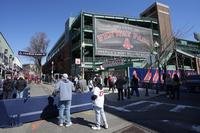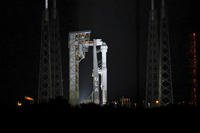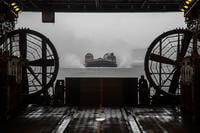Earlier this year, at a DC conference on laser weapons, Brigadier General Philip Coker, with the Army's Training and Doctrine Command, told the assembled scientists and defense contractors that they were on a 12-month deadline. You guys have been tinkering around with lasers for decades, he said, without a whole lot of funding or a whole lot of success. But if you come up with a ray gun that can protect American troops in Iraq from mortar attacks within the next year, "I will buy it." And then, the money will rush for all sorts of so-called "directed energy" weapons.
You guys have been tinkering around with lasers for decades, he said, without a whole lot of funding or a whole lot of success. But if you come up with a ray gun that can protect American troops in Iraq from mortar attacks within the next year, "I will buy it." And then, the money will rush for all sorts of so-called "directed energy" weapons.
But it looks like that deadline won't be hit. Because "U.S. Army officials so far have balked at deploying an experimental laser weapon" that's the most promising candidate for fulfilling Coker's needs, Reuters says.
"We've talked to them about it," said Art Stephenson, a vice president at Northrop Grumman Corp., which built the Tactical High-Energy Laser, or THEL.
THEL, a short-range air defense system made up of several components, is the laser weapon closest to possible use in the field. It ties an advanced radar that detects and tracks incoming rockets to a chemically-generated high-power beam that destroys them. The system's development was jointly funded by the U.S. Army and the Israeli Ministry of Defense.
Army officers had lots of questions about logistics and safety, Stephenson told reporters...
"And there are answers to all those questions that alleviate those concerns," he said. "It's up to the military to decide how they want to use this capability."
Army officials involved in the matter would not be available for comment until Thursday, said Nancy Ray, an Army spokeswoman.
In tests at the White Sands Missile Range in New Mexico, THEL has destroyed 46 targets in flight, including mortar rounds fired singly and in salvos, artillery shells and rockets, Northrop officials said. A target is zapped by the real-life equivalent of a Star Trek-like beam of light. The highly focused beam, generated by a mix of hydrogen fluoride and deuterium fluoride, focuses enough energy to heat the target until it explodes in mid-air.
Stephenson, vice president of Northrop's new "Directed Energy Systems" business area, said the Army pulled the plug late last year on plans to develop a mobile version of THEL on the grounds it would be too bulky.
Since then, Los Angeles-based Northrop has designed a second-generation, "relocatable" system that's about one-quarter the size of the one now at White Sands, New Mexico, with the same capability, he said.
The "relocatable" system could be deployed within two years at about $25 million apiece from the 30th unit if the Army were to buy that many of them, he said.
So far, that's not in the cards.







